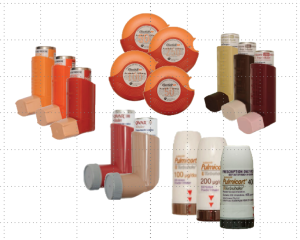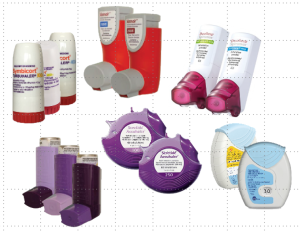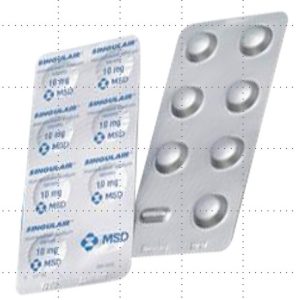Asthma treatment
- Asthma Medications
- Reliever Medications
- Preventer Medications
- Montelukast
- Biologics
- Oral Steroids
- Atrovent
- Home Nebulisers
- Non-medicine approaches to asthma management
Medication plays a crucial role in keeping you well and your asthma under control.
It is important to understand how your medicines work and then to take them as directed by your healthcare practitioner.
Asthma medications work very well when taken correctly. However, about 80% of people in New Zealand who use asthma medications, do not use them properly. This means many people put up with asthma symptoms when they don’t need to and their everyday life is affected.
When asthma medications are used incorrectly, this increases the risk of poorly controlled asthma (include link). Even if you think you are using your inhaler right, it is recommended you ask your doctor or nurse to check your technique – check out our range of device technique videos here.
Always check with your doctor or pharmacist if you experience side effects or you think your medication is not working as it should.
Asthma New Zealand recommends that everyone with asthma should have an asthma action plan. This should include insgtructions about how to manage your asthma when it is well controlled, partially controlled or uncontrolled.
Always check your medication expiry date and exact storage instructions. Most asthma medications require storage at room temperature.
Most asthma medications require a prescription from your doctor or nurse. It is important to ensure you never run out of inhalers, especially if you are heading away overseas or on holiday.
Reliever inhalers
Reliever inhalers (also known as rescue inhalers or ‘band-aids’) are an important part of asthma treatment, however they should only be used to treat asthma symptoms (add link here) or in an asthma emergency.
When well, you should not be using more than 2 puffs of your reliever inhaler each week. Using more than this could indicate your asthma may not be well controlled.
There are three types of medications that can be used to treat the symptoms of asthma.Web – relievers
- Salbutamol – a group of reliever medications including Ventolin, Salair and Respigen
- Contains salbutamol
- Anti-inflammatory Reliever (AIR) Inhalers – includes Symbicort and Duoresp Spiromax
- Contains budesonide/formoterol
- Bricanyl Turbuhaler
- Contains Terbutaline Sulfate

How relievers work
- Only medication that will work quickly in emergencies
- Work quickly within 2-5 minutes and effects last for 4-6 hours
- Normal dose is 1-2 puffs every 4-6 hours (always use as prescribed) for symptom relief
- They relax the smooth muscles on the outside of the airways, easing symptoms
- Think of them like a band-aid – they deal with symptoms but not the underlying inflammation in the lungs
- Relieves the symptoms of asthma (shortness of breath, tight chest, cough and wheeze)
- Can be used when unwell with a cold, especially if this is a trigger for you (talk to your doctor first and follow your action plan)
- Can be used before taking part in exercise or sports, if you know physical activity is a trigger for you
- Use 1-2 puffs 15 minutes before physical activity to help prevent any symptoms
- Always carry your reliever inhaler (and spacer if using an MDI) around with you
Using relievers in an emergency
Click here to see how to use your inhaler in an emergency
Preventer inhalers are the ‘hero’s’ of asthma management and are the most important part of managing asthma. They contain an inhaled corticosteroid (ICS).
In New Zealand, anyone who is over the age of 12 who has asthma or suspected of having asthma should be prescribed and using a preventer inhaler. This is because research tells us that it is not safe for people to only use a reliever inhaler.
Reliever inhalers should not be your primary method of controlling asthma. If you rely on them often, it could mean your daily preventer medication needs adjusting. Speak with us or your doctor to ensure your asthma is properly managed.
Click here to see the difference between preventers and relievers.
There are two groups of preventer medications:
- Inhaled corticosteroid (ICS) only

- Combination (includes ICS and a long-acting reliever)

ICS only preventer inhalers include:
- Flixotide
- Beclazone
- Pulmicort
- Qvar
Combination preventer inhalers are:
- Seretide
- Breo
- Symbicort
- Vannair
- Duoresp Spiromax
Preventer inhalers work by:
- Mimicking our bodies own naturally occurring cortisol
- Controlling the swelling, redness and mucous build-up inside the airways of the lungs
- Making the airways less sensitive to asthma triggers
- Minimising asthma being triggered
- Reducing the risk of asthma attacks and hospitalisations
- Preventing long term damage to our lungs (also known as airway remodelling)
Are combination inhalers different to ICS only inhalers?
Combination inhalers have an added long-acting reliever component to them which works on both the inside and outside of the airway – making them slightly different to regular ICS only preventers. These may be prescribed for those who:
- Are not adequately managed using an ICS only preventer inhaler (despite regular, consistent use)
- Experience nighttime or early morning symptoms
- Have severe asthma
- Corticosteroid helps make the airways less sensitive, reduces redness and swelling and helps to dry up excess mucus.
- Long-acting bronchodilators relax tight airway muscles for up to 12 hours (some up to 24 hours).
How long do they start to take to work?
In order for preventer inhalers to work, they must be used every day (usually morning and night) as prescribed, even if you feel like your asthma is well controlled. They can take 2-6 weeks to start to see an improvement. Because people don’t see a quick response to this medication, like they do with their reliever inhaler, they often think the medicine is not working and stop it before it has a chance to work – it is important to keep going with this even if you don’t see an improvement straight away!
Some combination preventers work within a few minutes (Symbicort and Duoresp Spiromax) and particular strengths of these can be prescribed as both a preventer and reliever (also known as anti-inflammatory relievers). Other combination preventers cannot be used as relievers, as they take much longer to have an effect on tight airway muscles. Make sure you know which one you have been prescribed.
What are the side effects?
- Sore throat
- Hoarse voice
- Oral thrush
Like with any medication, whether man-made or natural, side effects can occur. To help prevent these potential side effects, it is important to:
- Use medication as directed
- Use a spacer if using an MDI
- Rinse mouth with water, gargle and spit out after ICS use (don’t swallow)
- Wipe around a child’s face after ICS use, if using a mask with the spacer
Want a printable version of the different asthma medications available in NZ? Click here
Montelukast (also known as Singulair) belongs to a group of medicines called leukotriene receptor antagonists and work by blocking substances called leukotrienes that cause narrowing and swelling of the airways and allergy symptoms. Blocking these leukotriene substances improves asthma symptoms and helps prevent asthma attacks. It is a type of anti-inflammatory medication that is used to treat and prevent asthma symptoms including:
- Day and night symptoms
- Exercise-induced asthma symptoms
- Seasonal and year-round allergies (also known as hay fever or allergic rhinitis), including runny nose, nasal congestion/itching and sneezing
Montelukast can be used as an add on to preventer inhaler therapy and in some cases, can be used as the only preventer anti-inflammatory medication.
Montelukast cannot be used as a reliever medication or in emergencies.
In New Zealand, Montelukast comes in tablet form – 4mg and 5mg (chewable) and 10mg (non-chewable tablet).
Like every medication, it is important to be aware of potential side effects. For information about Montelukast and side effects, click here.

– severe allergic asthma
Sometimes, when asthma is severe or following an asthma attack, your doctor or nurse may prescribe you or your child a short course of oral steroids (such as prednisone, prednisolone, redi-pred). These medicines work by calming down the inflammation and swelling in the airways, helping you or your child to breathe more easily and recover from an asthma flare-up/attack.
Oral steroids are usually very effective for getting asthma back under control, but they are not a long-term solution. Regular use can cause unwanted side effects such as changes to growth, bone strength, and the immune system. Because of this, research suggests that the safe lifetime total should not exceed about 1 gram (roughly four standard courses).
Oral steroids, like any medication, can cause side effects. Common side effects include:
- Nausea (feeling sick)
- Vomiting
- Increased appetite
- Indigestion or heartburn
- Stomach bloating or irritation
- Diarrhoea or constipation
- Mood change
The goal is always to keep asthma so well controlled with daily preventer medicine that oral steroids are rarely, if ever, needed. If you or your child is needing oral steroids, it’s a sign their asthma management plan may need reviewing.
Alongside using your inhalers as prescribed, there are many everyday things you can do to help reduce asthma symptoms and stay well:
- Keep your home warm and dry – Damp and mould can trigger asthma. Aim for around 18–20°C indoors, use a dehumidifier or ventilation if needed, and fix leaks promptly
- Avoid smoking and vaping – Smoke and vape particles irritate the lungs and make asthma worse. Keep your home and car smokefree/vapefree
- Reduce allergens – Dust mites, mould, pollen, and pet dander can all trigger asthma. Vacuum regularly, wash bedding weekly in hot water, and reduce clutter where dust collects
- Maintain a healthy lifestyle – A balanced diet, staying active, and getting enough sleep all help strengthen your immune system and improve lung health
- Manage weight and fitness – Regular activity can improve lung capacity, and maintaining a healthy weight may reduce asthma symptoms
- Breathe through your nose – Nose breathing warms, filters, and moistens the air before it reaches your lungs, which can reduce irritation
- Identify and avoid triggers – Keep track of what makes your asthma worse (e.g., cold air, exercise, pollen, colds/flu), and work with your doctor to plan around them
- Keep up with vaccinations – Annual flu and COVID-19 vaccines reduce the risk of serious illness that can trigger asthma attacks
- Good hand hygiene – Washing hands regularly and avoiding close contact with people who are unwell can help reduce colds and flu, which often worsen asthma
- Stress management – Stress and anxiety can make asthma symptoms worse. Relaxation techniques, mindfulness, or gentle activities like yoga or tai chi can help
- Regular asthma check-ups – Even if you’re feeling well, a yearly review helps ensure your asthma is controlled and your action plan is up to date
- Breathing patterns – If you think you may have a breathing pattern disorder (I.e. you notice you regularly shallow breathe or hyperventilate), getting in touch with a breathing physio or specialist may help